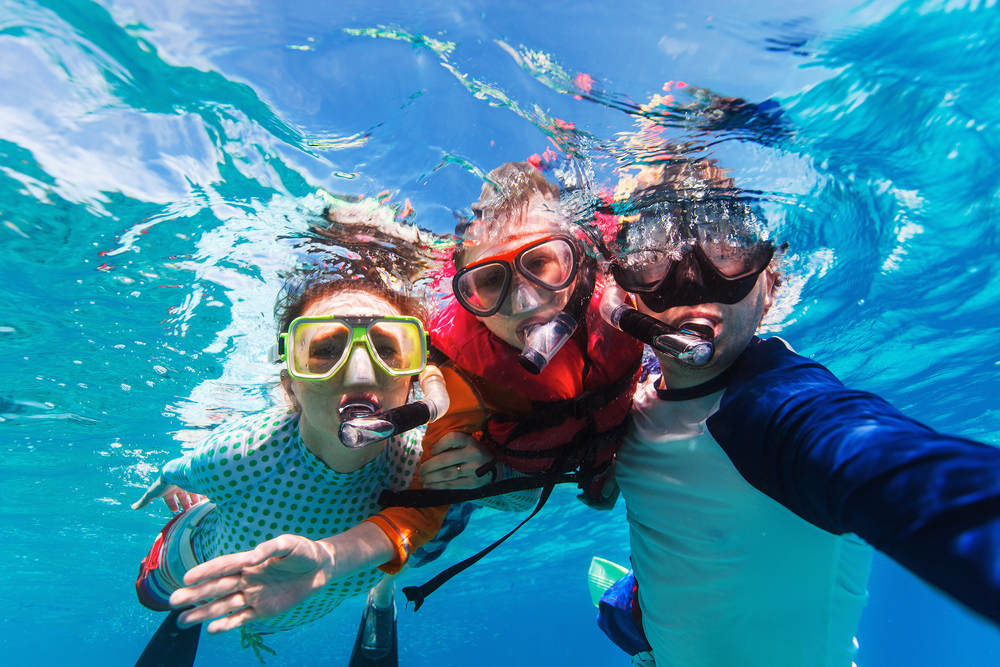Learning how to snorkel is not so tricky. Our team has prepared this handy guide, packed with tips on how to get started. You will be snorkeling with the best of them in no time at all.
Practice Your Swimming, but Don’t Lost Too Much Sleep Over It
Swimming is obviously a big part of snorkeling. When you learn how to snorkel, you will be completely submerged, and you will be using the power of your arms and legs to move around, so it stands to reason that you must be able to swim to some extent before you begin.
But if you are not an excellent swimmer, there is no need to worry. The important thing here is to feel confident in the water and to have the swimming and water-treading skills necessary to be calm and relaxed while you snorkel. Beyond this, swimming is not so important. Practice your swimming by all means, but don’t be put off if your 50-meter time is not quite at Olympic standard.

Get to Know Your Equipment
You will be getting up close and very, very personal with your swimming mask and your snorkel when you learn, so it is important to get used to this equipment early on. With your feet firmly on the floor, practice wearing your equipment, and putting your face in the water. This will ease you into the process.
Again, comfort and calm are key factors here. You need to be able to trust your equipment when you start snorkeling for real, so it is important to build a good relationship with this equipment from the start. Then you will be confident enough to really enjoy your snorkeling.
Double Check Your Equipment
You don’t want water to start leaking in midway through your snorkeling session. When you learn how to snorkel, it is important to check that your mask fits your face, to eliminate the possibility of this happening.
To do this, hold the mask up to your face and then breath in through your nose. This will create a tight, but not uncomfortable, seal around your nose and eyes, with no water leakage at all. Remove your hands from the mask and if it fits it should not move.
Fins are Your Friend
Mobility is vital when snorkeling. You need to have the swimming power required to stay in one position even when the water gets choppy, and you need to be able to move to different locations as and when you see fit. However, snorkeling is still a visual exercise, and your enjoyment depends on the clarity of what you are able to see. With this in mind, you don’t want to be churning up the water around you with unnecessary arm movements.
This is why you need fins. If you are not used to wearing fins, you may feel a little uncomfortable with wearing something on your feet when you swim, and so you may decide to do without. However, without fins, it will be far more difficult for you to get the mobility you need without disturbing the water.
So, get into the habit of wearing these handy pieces of equipment sooner rather than later. Wear your flippers when you learn how to snorkel and reap the benefits of swift, easy movement in the water.
Take Baby Steps
Snorkelling is a charming, gentle activity which all can enjoy, but this does not mean it is without its dangers. Any pastime which involves swimming in deep water – whether just off the beach or from your luxury catamaran – is always going to come with an element of risk, so it is up to you to minimize this risk wherever you can.
You might be beginning to notice a few common themes in this guide – the themes of comfort and confidence. These are important, because snorkeling is not an endurance test or an extreme sport, but is instead an activity to be savored and enjoyed.
Don’t push your boundaries too far, don’t go out of your comfort zone, and take baby steps into the world of snorkeling. This is how to snorkel in a fun and safe way, having fun throughout, with none of the danger or anxiety which comes from more extreme forms of diving.
Buddy Up
To minimize your risk further, remember always to buddy up when you snorkel, particularly when you are still learning. Not only will this mean that there is always someone who knows where you are, and can help you if you get yourself into difficulty, but it will also enhance your enjoyment and introduce a social element to the fun.
When you are still taking your first steps into snorkeling, it may be helpful to buddy up with someone who is more experienced and who can show you the ropes. This means that you will have someone there to demonstrate the practical aspects of snorkeling, helping you to learn all the more quickly.
Remember Your Breathing Techniques
One of the more difficult aspects of snorkeling is getting used to breathing through a small mouthpiece. Generally, on land, we take deep breaths in through our nose at our leisure, so exchanging this method for a plastic tube which connects directly to the mouth can be strange at first.
Remember to stay calm – there’s that word again – and to take slow, measured breaths. If any sea water comes down the snorkel, don’t panic, simply blow it back out again and carry on. If you need to, simply lift your face out of the water and breathe normally. Stay calm, stay confident, and stay in control.
Get Used to Defogging
Unfortunately, your mask is going to fog up from time to time. In order to get the best out of your snorkelling experience, you need to be able to defog whenever this is required.
Keep a defogging gel handy – a small drop of baby shampoo will even work in this instance, although ready-made defogging products are better – and use this to keep your mask fog free.
Do you want to gain more tips on learning how to snorkel? Would you like to discover more about the great yacht and catamaran options from Adventure SS Luxury Catamaran? Get in touch with our team today.


